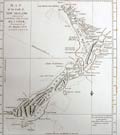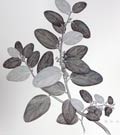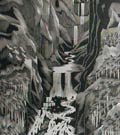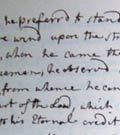Cabinet 18 - The Antipodean Legacy
 The first voyage under Captain Cook on the HMS Endeavour was primarily of a scientific nature. The expedition was to sail to Tahiti in order to observe the transit of Venus, as well as to carry on the geographical discovery that John Byron in the Dolphin had started (Silveira de Braganza et al.). Joseph Banks and Daniel Solander carried out extensive ethnological, zoological and botanical research. Hawkesworth, a well-known London author, was commissioned by the Admiralty to prepare the narratives for publication. He received £6000 for his editorial labours. The engraving depicts the pa site that Banks and Solander explored 'after breakfast' on Sunday 12 November 1769.
The first voyage under Captain Cook on the HMS Endeavour was primarily of a scientific nature. The expedition was to sail to Tahiti in order to observe the transit of Venus, as well as to carry on the geographical discovery that John Byron in the Dolphin had started (Silveira de Braganza et al.). Joseph Banks and Daniel Solander carried out extensive ethnological, zoological and botanical research. Hawkesworth, a well-known London author, was commissioned by the Admiralty to prepare the narratives for publication. He received £6000 for his editorial labours. The engraving depicts the pa site that Banks and Solander explored 'after breakfast' on Sunday 12 November 1769.
John Hawkesworth, An Account of the Voyages...for Making Discoveries in the Southern Hemisphere. Vol. II. London: Printed for W. Strahan; and T. Cadell, 1773. DeB Ec 1773 H
 Just before Cook's first voyage began, the amateur naturalist John Ellis (?1710-1776) wrote to Linnaeus stating: 'No people ever went to sea better fitted out for the purpose of Natural History.' Of course Ellis was talking about Joseph Banks and Sydney Parkinson, an artist who, according to Banks, had 'unbounded industry.' Parkinson made numerous drawings of botanical and other subjects, including landscapes and portraits of native chiefs. Unfortunately, he died of fever on the return journey and it was left to his brother Stanfield to edit and publish his journal. His drawings certainly helped the process of classification (based on the Linnaean system) back in England. On display is the famous 'Banks Island' map of New Zealand.
Just before Cook's first voyage began, the amateur naturalist John Ellis (?1710-1776) wrote to Linnaeus stating: 'No people ever went to sea better fitted out for the purpose of Natural History.' Of course Ellis was talking about Joseph Banks and Sydney Parkinson, an artist who, according to Banks, had 'unbounded industry.' Parkinson made numerous drawings of botanical and other subjects, including landscapes and portraits of native chiefs. Unfortunately, he died of fever on the return journey and it was left to his brother Stanfield to edit and publish his journal. His drawings certainly helped the process of classification (based on the Linnaean system) back in England. On display is the famous 'Banks Island' map of New Zealand.
Sydney Parkinson, A Journal of a Voyage to the South Seas. London: Printed for Stanfield Parkinson, 1773. DeB Ec 1773 P
 Joseph Banks and Daniel Solander collected thousands of specimens of plants during Cook's first voyage of 1768-71. This black and white reproduction of an engraving of 'Adeliodies decumbens' is one of many reproduced in the British Museum publication of 1904-5 dealing specifically with Australian plants.
Joseph Banks and Daniel Solander collected thousands of specimens of plants during Cook's first voyage of 1768-71. This black and white reproduction of an engraving of 'Adeliodies decumbens' is one of many reproduced in the British Museum publication of 1904-5 dealing specifically with Australian plants.
'Adelioides Decumbens', No. 5, Illustrations of Australian plants collected in 1770 during Captain Cook's voyage round the world in H.M.S. Endeavour. London: Printed by order of the British Museum: sold by Longmans etc., 1900-1905. Special QK431.B625
 When Captain James Cook reached the Cape Colony in 1772, he consented to John Reinhold Forster's wishes that Anders Sparrman (1748-1820) be employed as an extra botanist on HMS Resolution. Sparrman was one of Linnaeus's best pupils, and was in South Africa on a botanical expedition on behalf of the Swedish government. Sparrman's narrative of his journey was written years after the event and he had the benefit of quoting other sources, including Cook, Forster, Vancouver and Bougainville. This Golden Cockerel Press edition, with superb wood-engravings by Peter Barker-Mill, is the first English translation.
When Captain James Cook reached the Cape Colony in 1772, he consented to John Reinhold Forster's wishes that Anders Sparrman (1748-1820) be employed as an extra botanist on HMS Resolution. Sparrman was one of Linnaeus's best pupils, and was in South Africa on a botanical expedition on behalf of the Swedish government. Sparrman's narrative of his journey was written years after the event and he had the benefit of quoting other sources, including Cook, Forster, Vancouver and Bougainville. This Golden Cockerel Press edition, with superb wood-engravings by Peter Barker-Mill, is the first English translation.
Anders Sparrman, A voyage round the world with Captain James Cook in H.M.S. Resolution. [London]: Golden Cockerel Press, 1944. Hocken KUC, B Sp
 Sir Joseph Banks was an aristocrat who had the money to fund his private botanical obsessions. Carl Linnaeus, the minister's son, had to bargain for and borrow money to continue his botanical pursuits. Although there is a hint of their corresponding, they never met. Banks was particularly important in that he was an advocate of the Linnaean system, using his numerous networks to spread the word. A key figure was Daniel Solander, one of Linnaeus's 'Apostles', whom Banks hired to classify thousands of new and exotic plants that he had obtained during the first voyage with Cook. Banks's hand-written entries on birds and insects in New Zealand are from a facsimile copy of his Journal. This is no. 218 of 500 copies.
Sir Joseph Banks was an aristocrat who had the money to fund his private botanical obsessions. Carl Linnaeus, the minister's son, had to bargain for and borrow money to continue his botanical pursuits. Although there is a hint of their corresponding, they never met. Banks was particularly important in that he was an advocate of the Linnaean system, using his numerous networks to spread the word. A key figure was Daniel Solander, one of Linnaeus's 'Apostles', whom Banks hired to classify thousands of new and exotic plants that he had obtained during the first voyage with Cook. Banks's hand-written entries on birds and insects in New Zealand are from a facsimile copy of his Journal. This is no. 218 of 500 copies.
